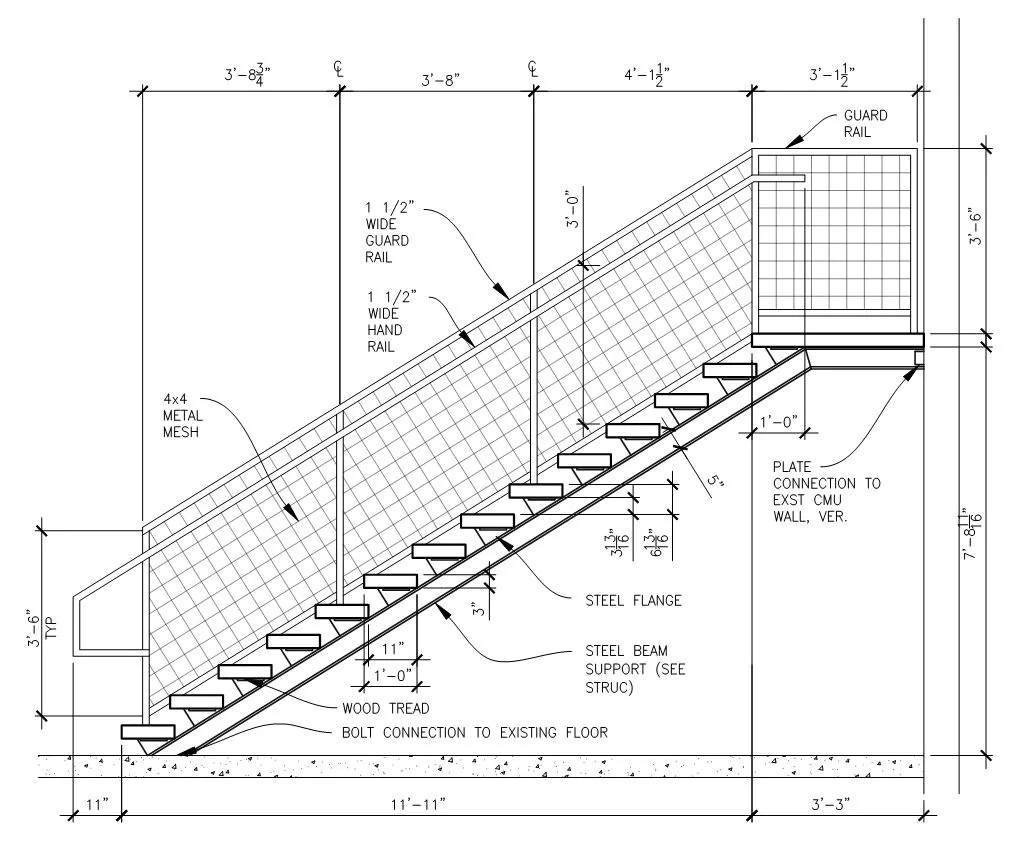The IBC (International Building Code) prescribes minimum requirements for the design of stairs, ramps, and their railings. These are very important features to a building that are included in the code to ensure safe access and egress from buildings, under both normal and emergency situations. Here is a summary of these main requirements!
“Rise & Run” Defined
Nope! For our purposes here, this doesn’t mean waking up early for a jog! But, its almost as simple as that.
The rise of a stair is the length of the vertical portion at each step. The run of a stair is the horizontal length at each step. For a ramp, the rise means the vertical dimension, versus the run being the horizontal dimension.
Basic Stair Code Compliance
Rise & Run Dimensions: Stairs in commercial buildings are required to have a rise between 4″ and 7″, and a run of 11″ between nosings. There are exceptions to have smaller dimensions of rise and run for certain dwelling units and certain other cases. Also, buildings under the IRC (International Residential Code) have different requirements. This is mostly regarding single family homes.
Stair Width: The width of stairs shall be 36″ minimum ( if serving under 50 occupants). Otherwise, the minimum width is 44″. If a stair is required to be an “accessible means of egress”, it must have a width of 48″ between handrails.
Stair Uniformity: There must be uniformity of all the steps. Meaning you cant have 1 step be a 7″ rise, and the next step be a 5″ rise. The maximum tolerance for difference is 3/8″.
Handrails & Guardrails Basic Code Compliance
Handrails are, as the name would imply, something to hold on to with your hand, for balance, stability, and guidance up and down stairs. Guard rails are for the purpose of protecting someone from falling over the edge of a stair or any raised area.
Guardrails Required & Height: In general, guard rails shall be provided on any stair, ramp, or raised surface over 30″ in height. Guards shall usually be a min. of 42″ in height.
Guardrail Openings: Guardrails shall not have openings that allow passage of a sphere 4″ in diameter. This can be achieved in many ways, such as providing a 4″x4″ steel mesh, or horizontal wires spaces at 4″. They can be built out concrete, wood, glass, metal, etc. Please see the IBC, chapter 10 for exceptions to some of these requirements. 
Handrails required: Handrails are required at most stairs and ramps. They are generally required to be on both sides of the stair (Residential is usually only 1 side).
Handrail height and dimensions: Height is between 34″-38″ above the stair nosings. 36″ is usually a good safe height. Circular handrails are required to be between 1.25″- 2″ in diameter. Non-circular handrails are permitted. Please see the code for those detailed requirements.
Handrail extensions: Handrails must extend past the top and bottom of stairs. At the top, they must extend 12″ horizontally past the top riser. At the bottom riser, the handrail must continue to slope for the horizontal depth of 1 tread. Handrails must also terminate at a wall, guard, or walking surface. Basically, they don’t want to have a metal pole sticking out that someone can impale themselves on.
Handrail Projection: Handrails can project into the stair required width (36″ or 42″) no more than 4.5″ projection. For accessible stairs, handrails are not permitted to project into the required 48″ width. So, an accessible stair overall width would typically be at least 48″ + 3″ each side for handrails.
Ramps
Ramps can serve to meet the accessible access of a building or area where there is a change in level.
Slope/ AKA Rise v Run: If a ramp is provided, it must be at no greater slope than 1 vertical to 12 horizontal. So, for example, a 12″ vertical rise would require a 144″ (12′) horizontal run.
Where the slope is less than 1:20 (5% slope) this is essentially not considered a ramp.
Width: Ramps shall be a minimum of 36″ wide, with other exceptions requiring larger widths.
Max Rise: The maximum rise of a ramp is 30″, so for every 30″ rise, you must have a flat landing.
Landings: Landings must be 60″ minimum. Switchback landings must be at least 60″x 60″.
Guards & Railings: Requirements for guards and railings for ramps are similar to those mentioned above.
Wrap Up
We hope you learned some helpful info about stairs, ramps, etc! Please keep in mind, this is not an all inclusive description of all the requirements. Please refer to the IBC (Mostly chapter 10 for this content) or IRC for further details! Thanks!